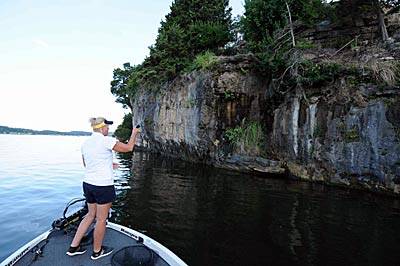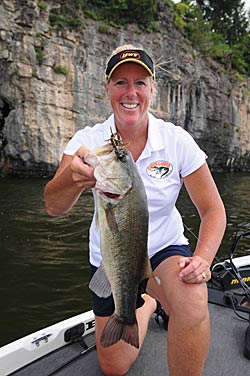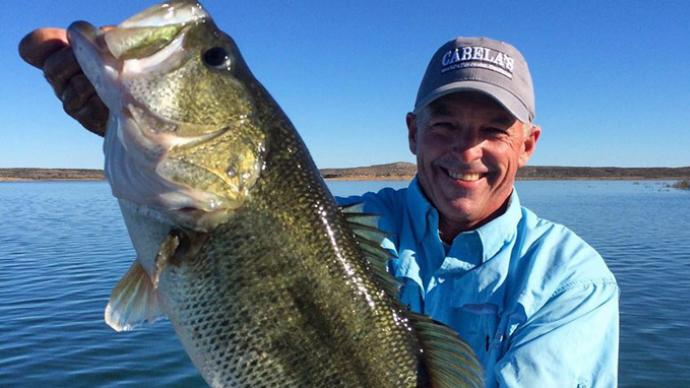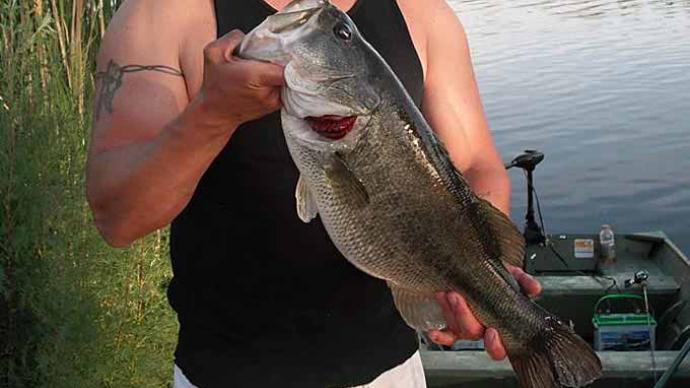
Denise Dill likens a lake’s bluff to a grocery store checkout lane.
She notices current along a bluff funnels food to a bass, similar to how the conveyor belt at the grocery checkout pushes food down to a bagger. The food funneled to bass hanging on bluffs becomes a good summertime pattern for Dill, who guides on Lake of the Ozarks with her husband, James Dill. “The fish can kind of position themselves either right on the (bluff) points or off the points a little bit and can feed on their food coming down through the current,” Dill says.
A bluff is also a perfect feeding spot for summertime bass because the structure provides quick access to shallow and deep water. Bass can move up to the shallows of the bluffs to feed and can quickly retreat a short distance to cooler deep water when the fish finish feeding. Dill prefers targeting main lake bluffs rather than bluffs in creek arms of a lake in the summertime because the current is stronger and more fish are out on the main lake then.
Short bluffs allow Dill to fish the entire length of the rock wall, but bluffs that stretch for thousands of feet or even a mile require her to look for sweet spots along the structure. She mostly avoids fishing the sheer walls of bluffs because the structure lacks the ledges bass prefer holding on during the summer. “I always look for irregularities in the rock where there is a rock slide of bigger boulders,” Dill says. She also targets any isolated large chunk rocks sticking out from the bluff wall.
The Missouri guide positions her boat close enough to the bluff to where she can cast her lure to the shallows and stair-step it down the ledges of the rock wall. “I get about two boat lengths away or sometimes even closer to the bluff,” Dill says. She notices most of the fish she catches are about 10 feet deep.
Her favorite lures for summertime bluff bass are a finesse worm or Zoom Mag Trick Worm attached to a 1/4-ounce Crock-O-Gator Bait Company Shaker Football Head jig, a Crock-O-Gator Swamp Bug with the same Shaker Football Head and a 1/2-ounce Crock-O-Gator Zapper Jig tipped with a Crock-O-Gator Ring Craw or Zoom Brush Hog. She throws all three lures on a 6-foot, 10-inch Falcon Cara Finesse Jig rod and Lew’s Tournament Pro Speed Spool baitcast reel filled with 15-pound test Berkley 100 % Fluorocarbon line.

Dill casts her lure as close to the bank as she can and then experiments with her retrieve until she gets a bite. “A lot of times, I will start my retrieve fairly slow, just bouncing it right off the rocks or the ledges, and then sometimes I kind of hop it a little bit more and work it a little bit faster to give it a little more action,” she says.
Bass frequently hit her lures on the fall, so Dill prefers the lighter weight jigs because the lures descend slower and stay in the bass’ strike zone longer. Heavier jigs tend to fall past the fish too fast and hang up more in the rocks.
The Missouri guide and tournament competitor works all three of her lures the same way, and the key to her presentation is keeping constant contact with the rocks. “I am creating a disturbance that draws the fish to my bait by knocking it up against the rocks and crevices,” she says. “It’s a big help on the bite.”
Dill bounces her lure down the rocky ledges until it falls off into the deep. “Once the lure starts free falling, that is when I usually reel it back in and recast,” she says.
When she is guiding, Dill notices the biggest mistake her clients make while fishing bluffs is working their lures too fast to avoid snagging up in the rocks. “It’s a Catch-22 situation,” Dill says. “You need to work the bait slowly, but if you work it too slowly, you get hung up all the time.”
Dill suggests bluffs are good spots to catch summertime bass for anglers who lack experience using electronics. “The good thing about bluff fishing is a lot of it is visual,” she says. “A lot of people can fish bluffs because they can look for those irregular spots on the bluff. It is something that anyone can fish.”
The Missouri angler mainly refers to her electronics to keep her boat close to any drop-offs or cover along the bluffs. “I don’t necessarily need my graphs except to know where some brush piles are,” she says. “I am just fishing in the shade of the bluff most of the time.”
Dill notes she relies on her lures to determine the depth she needs to fish along the bluffs. She bounces the lure down the bluff ledges and reels it in when she no longer feels the lure hitting bottom.
The bluffs produce good numbers of bass for Dill throughout the summer. “I have caught some good ones out on the bluffs, but it’s more so 2- to 3-pounders,” she says.
BassResource may receive a portion of revenues if you make a purchase using a link above.




